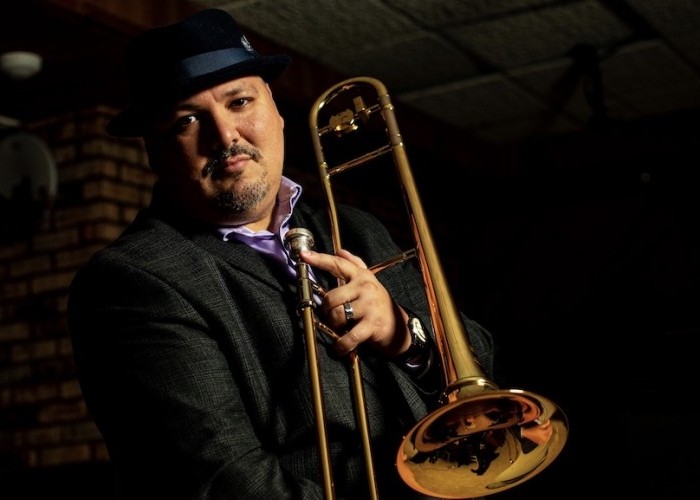Oct 28, 2025 10:47 AM
In Memoriam: Jack DeJohnette, 1942–2025
Jack DeJohnette, a bold and resourceful drummer and NEA Jazz Master who forged a unique vocabulary on the kit over his…

Michael Dease is the Trombonist of the Year in DownBeat’s 69th Annual Critics Poll.
(Photo: Jessica Cowles)Michael Dease took a circuitous route to discovering his chosen instrument. He started out as an alto saxophonist during high school, occasionally playing a little trumpet.
“My heroes at that time were Grover Washington Jr. and Maceo Parker,” he said by phone from his home in Ohio. “I really had never heard any swing.”
But his mother, originally from Brooklyn, pointed him toward jazz.
“She said, ‘You can’t play saxophone and not know about Bird.’” His jazz journey eventually led him to John Coltrane, and “I really fumbled at it until I heard Curtis Fuller play on ‘Blue Train.’ … I was a saxophonist, and by the end of his solo on ‘Blue Train,’ I was a trombonist.” He switched instruments the next day, and has never looked back.
Dease took to the instrument with remarkable speed. “I did not know it was hard,” he says. “As soon as I got a trombone, I figured out the notes by ear and then I just counted down the slide. The first day I [ran scales] and everybody looked at me like I was crazy.
“From there, I started learning J.J. Johnson and Curtis Fuller solos by ear and playing along to the records. That was probably weeks two and three. And I was playing every day. I remember waking up at about 2 in the morning, afraid that I had rolled over on my trombone.”
After releasing three albums independently, Dease began recording for Posi-Tone Records with 2014’s Relentless. He’s made eight albums for the label to date, and appeared on many others as a sideman, part of label co-founder Marc Free’s efforts to build a stable of players in the manner of classic labels like Prestige and Blue Note. It’s an artistic fraternity of sorts, a mutually supportive network, and Dease is proud to be a member.
“I always enjoy the sessions,” he said. “Posi-Tone has a strong focus on original music, so one session can be electronic, one session can be a retro look at some swing or bebop styles, but it’s always fresh and fun. I really respect what Marc is doing and how much freedom he gives the artists in choosing their direction and material and their story.”
Many of Dease’s albums are organized around a concept. All These Hands, from 2017, traced the path of jazz from south to north, from New Orleans to New York, expanding through the Midwest and the prairies in between. Individual tracks paid tribute to the contributions specific cities and regions made to the music, as titles like “Territory Blues,” “Chocolate City,” “Downtown Chi-Town” and “Memphis BBQ & Fish Fry” indicated.
His 2019 release, Never More Here, recorded with the same band (alto saxophonist Steve Wilson, pianist Renee Rosnes, bassist Gerald Cannon and drummer Lewis Nash), paid tribute to Charlie Parker in a sidelong way, by tracing Bird’s influence through the work of composers like Jimmy Heath, Jackie McLean, Billy Taylor, John Lewis and J.J. Johnson.
Dease’s latest album, Give It All You Got, came out in February. The music is straightahead hard-bop, with performances that mix slickness and grit and keep the energy level high at all times. Each of the album’s 10 compositions — six of which were written by Dease, one each by drummer Luther Allison and trumpeter Anthony Stanco, and two by organist Jim Alfredson — are thematically related to a two-week workshop Dease leads every summer at the Brevard Music Center in North Carolina. Some are tributes to fellow instructors, while others relate to aspects of the program or Dease’s attitude toward jazz education and bandleading.
That’s reflective of the trombonist’s belief that a jazz life is not only about individual success, but also about being part of a lineage. Just as he learned from Johnson, Fuller, Wycliffe Gordon, Steve Turre and others, Dease hopes to inspire younger players and pass on everything he’s learned.
“You can’t stop at just playing. You can’t stop at just touring or just teaching. You have to go the extra mile to ensure that the people behind you continue doing what the people ahead of you are doing — paying it forward and paying it back.” DB

Jack DeJohnette boasted a musical resume that was as long as it was fearsome.
Oct 28, 2025 10:47 AM
Jack DeJohnette, a bold and resourceful drummer and NEA Jazz Master who forged a unique vocabulary on the kit over his…

D’Angelo achieved commercial and critical success experimenting with a fusion of jazz, funk, soul, R&B and hip-hop.
Oct 14, 2025 1:47 PM
D’Angelo, a Grammy-winning R&B and neo-soul singer, guitarist and pianist who exerted a profound influence on 21st…

Kandace Springs channeled Shirley Horn’s deliberate phrasing and sublime self-accompaniment during her set at this year’s Pittsburgh International Jazz Festival.
Sep 30, 2025 12:28 PM
Janis Burley, the Pittsburgh International Jazz Festival’s founder and artistic director, did not, as might be…

Jim McNeely’s singular body of work had a profound and lasting influence on many of today’s top jazz composers in the U.S. and in Europe.
Oct 7, 2025 3:40 PM
Pianist Jim McNeely, one of the most distinguished large ensemble jazz composers of his generation, died Sept. 26 at…

Drummond was cherished by generations of mainstream jazz listeners and bandleaders for his authoritative tonal presence, a defining quality of his style most apparent when he played his instrument unamplified.
Nov 4, 2025 11:39 AM
Ray Drummond, a first-call bassist who appeared on hundreds of albums as a sideman for some of the top names in jazz…